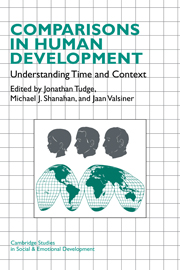Book contents
- Frontmatter
- Contents
- List of Contributors
- Comparisons in Human Development: To Begin a Conversation
- Part One Metatheoretical Approaches to Developmental Comparisons
- Part Two Paradigmatic Statements
- 4 Nested Comparisons in the Study of Historical Change and Individual Adaptation
- 5 The Value of Comparisons in Developmental Psychology
- 6 Implications from Developmental Cross-cultural Research for the Study of Acculturation in Western Civilizations
- Part Three Comparisons at the Level of Data
- Part Four Commentaries
- Author Index
- Subject Index
5 - The Value of Comparisons in Developmental Psychology
Published online by Cambridge University Press: 04 May 2010
- Frontmatter
- Contents
- List of Contributors
- Comparisons in Human Development: To Begin a Conversation
- Part One Metatheoretical Approaches to Developmental Comparisons
- Part Two Paradigmatic Statements
- 4 Nested Comparisons in the Study of Historical Change and Individual Adaptation
- 5 The Value of Comparisons in Developmental Psychology
- 6 Implications from Developmental Cross-cultural Research for the Study of Acculturation in Western Civilizations
- Part Three Comparisons at the Level of Data
- Part Four Commentaries
- Author Index
- Subject Index
Summary
Group comparisons are a ubiquitous phenomenon in developmental psychology. Empirical efforts abound with analyses of age, gender, and ethnic differences, as well as comparisons between securely and insecurely attached infants, peer–rejected and popular children, and authoritarian and authoritative parents. A survey of studies published in Child Development over the past 50 years bears this out; 68% to 88% employed cross–sectional and group comparison designs (Redmond, 1994). Given the discipline's penchant for this typological mode of inquiry, questions arise as to what we can expect to learn about development from an examination of differences between groups. Do group comparisons mask processes of change? Or can they be used to highlight developmental mechanisms that would otherwise be obscured in analyses of individual differences or singlesubject case studies of growth?
The purpose of this chapter is to discuss the potential value of group comparisons for studying development. Although some have criticized the study of group differences as nondevelopmental (e.g., Valsiner, 1984), we argue that there is nothing inherent in this approach to warrant such a conclusion. Instead, we hope to show that group comparisons can serve an important function in the programmatic study of developmental phenomena. We focus on three types of comparisons: gender, atypical children, and age group differences. Although by no means a comprehensive set, we believe the issues they raise extend to other, more topic–specific comparisons (e.g., abused versus nonabused children) as well.
- Type
- Chapter
- Information
- Comparisons in Human DevelopmentUnderstanding Time and Context, pp. 137 - 161Publisher: Cambridge University PressPrint publication year: 1996

